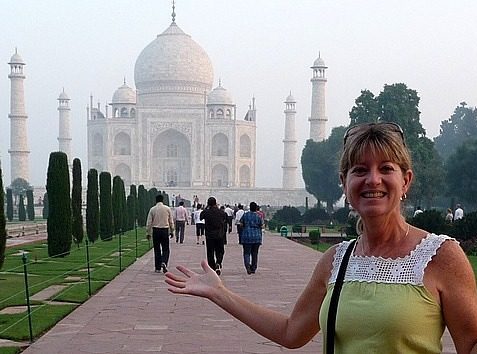My last day in Armenia started a little late because Prime Minister Trudeau is visiting Yerevan for the International Francophone Summit and with the Canadian Embassy is right down the road from my hotel the roads were closed periodically. (No I did not see Justin, but I did see the Air Canada jet at the airport when I was leaving today.). And, as it turned out, the roads were blocked off today until 11:00 a.m. At least that was the plan. However, the road remained closed at 11:00 a.m. because the Canadian party was still at the Genocide Museum. As a result, Nour had to park the car and he and Diane had to walk about three blocks to meet me and to help take my bags to the car.
Anyway, once we loaded the bags into the car, we headed southwest to the little town of Garni, the site of the Garni Temple, the only Roman designed building remaining in Armenia and all of the former Soviet Union.
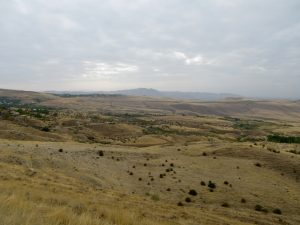
The trip south took us through some amazing high desert regions. At one point we stopped at a viewpoint for a look at the views to the valley below. Unfortunately, the high cloud prevented us from getting one more good look at Mt. Ararat, but the views were nevertheless beautiful.
Once we reached the Garni Temple, we walked through the entrance and took a look at a khachkar that dated to 879, which was found at the site of a church built adjacent to the temple. We then walked a little further on for my first look, and low and behold we could have been in Rome. The square building included 24 Roman columns (maybe signaling the hours in the day) with carvings of lions’ heads, date palms and leaves adorning the columns and carvings of Atlas and Titan adorning the entrance.


It is believed that the temple was built in the later half of the first century AD by King Tiridates I who had been crowned by Roman emperor Nero. It is also believed that as a gesture of goodwill, Nero provided the funding and the Roman craftsmen to construct the temple as a shrine to the ancient Armenian sun god Mihr. After Armenia’s conversion to Christianity in the early fourth century, the temple was converted into a royal summer house. The temple survived for centuries (which is a mystery in and of itself) until a 1679 earthquake destroyed the building. The temple was reconstructed using all of the original stones and columns between 1969 and 1975.
Now I was absolutely astonished at the site of the temple. It was as if I had been transported to Rome or Greece. We walked up the very steep steps to the top of the temple and then into the inner sanctum where, remarkably, there was not a single person. Excavations at the site have found evidence of animal sacrifices in the inner sanctum of the temple, and in fact there was a hole in the stone in front of the alter where the remains of animals had been found.

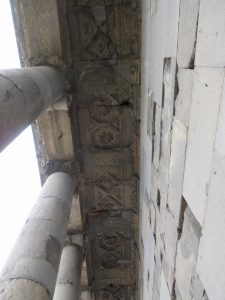
We then walked outside and between the temple and the columns. Fortunately, as we walked I looked up and the carvings in the ceiling were equally impressive. Once we completed one turn around the temple, we walked back down the narrow steps and headed for the baths. Yep, this place even had Roman style baths.
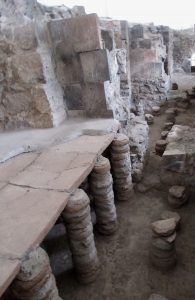
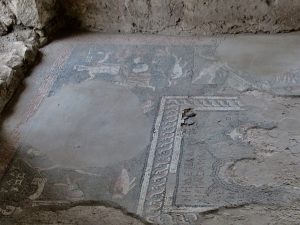
Now what I found odd was that the place was teeming with tourists; yet, the tour groups all seemed to be skipping the baths. And this was a real shame because the baths were very impressive complete with cold area, warm area and hot area as well as a separate bath for the queen, which came complete with a Roman fresco. Really lovely ruins virtually ignored by the masses.
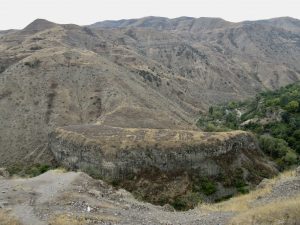
We then walked back towards the temple to a viewpoint where you could see the “Symphony of Stone”, so named because the lines in the rocks looked like sheet music. And one thing I should mention is that the views around the temple were magnificent. Mountains and deep gorges surrounded the temple and the Azat River passed close by. And while the mountains were all brown at this point in the year, once the summer rains hit the mountains “green up” and are said to be gorgeous in spring time.
Before we began to walk back to the car, we took a look at the ruins of the Sioni Church that had been built in the 7th century adjacent to the temple and was said to be a replica of the Zvartnot Temple I had visited the day before just outside Yerevan.
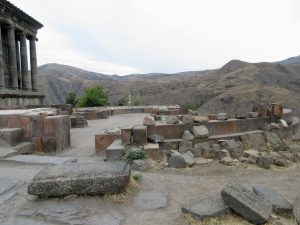
We then made our way back to the car for the short drive to our only other stop of the day, the Geghard Monastery, a UNESCO World Heritage Site. The name Geghard means spear and it is alleged that the spear that was used to stab Jesus after he was taken down from the cross (to ensure he was dead) was stored at the monastery and later moved to the Echmiadzin museum (where it was on a road trip to New York when I visited).
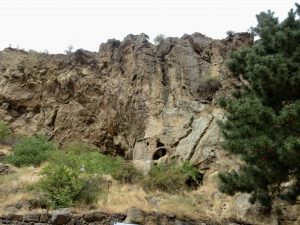
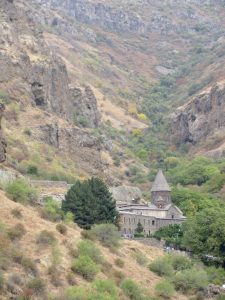
The monastery complex was apparently founded in the 4th century by Gregory the Illuminator at the site of a sacred spring, which still flows today. Now the amazing part of the monastery is that a majority of the little chapels are carved out of the surrounding cliffs. And as we approached the site, we passed by a number of cave cells that had been built and occupied by monks. The caves were a good distance up from the road and seemed to be open to the elements. Yikes!
So once at the site, we climbed up and around on some very rough cobblestones to the first level of the monastery. To the right was the bishop‘s quarters and offices and to the left was a short staircase to the first set of cave churches.
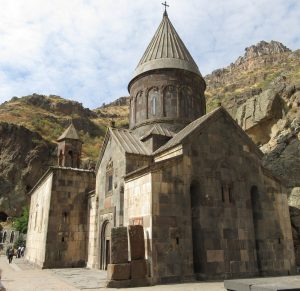
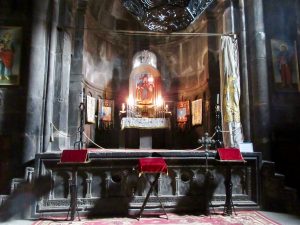
The first chapel we visited was the Katoghikeh Chapel that was used by those who were not royal. The chapel was made of stone and was preceded by the standard entryway that included a mausoleum. The chapel and entryway were free standing and not built into the cliffs.
The next sites we entered were cave churches and a vestibule and were absolutely fantastic. The first two, the Proshian chapel (vestibule) and the Holy Mother of God main church were remarkable for the outstanding carvings in the stone and for the very fact that the rooms had been carved out of massive stone cliffs.
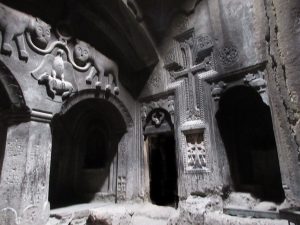
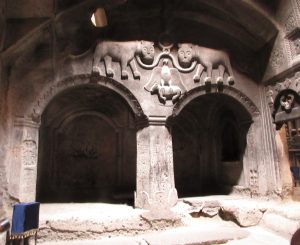
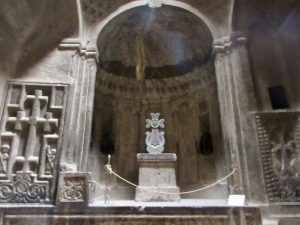
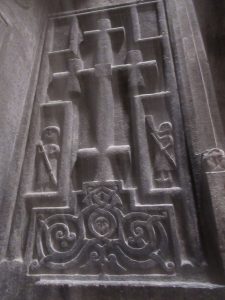
The vestibule, built between 1215 and 1225, featured animals, an eagle, kuchkars and carvings of people above the doorway to the Holy Mother of God church. And the Holy Mother of God church, which was the main church at the site, had similar carvings and was incredibly atmospheric. Quite frankly, the vestibule and church may have contained the most well preserved carvings I had seen throughout the Caucuses. Simply amazing to think how old the carvings were and how long it took to carve these churches (over 40 years).
The last cave we visited on the main level was the Avazan cave church, which contained the famous holy water spring. We made two attempts to visit the church, but the line to taste this water was huge. After the second effort, we decided to simply wait it out. After about ten minutes, Diane pushed me towards the front and I finally had my turn. The water was a bit on the sweet side and cold. I told Diane it was quite refreshing or as my Nana used to say when she had her vodka and orange juice, “my that’s refreshing.”


We exited the cave churches on the main level and then climbed one level to the last cave, which housed the Papak and Ruzukan vestibule. We had to walk through a long passageway lined with khachkars before entering the domed room with massive columns. Now the acoustics in the room are fantastic and as we arrived, a group of four singers were getting ready to perform. We stood and listened to the beautiful song and the acoustics really were amazing. At the end of the first song, I made the “horrid” mistake of clapping. Apparently that was a big no, and I received a death stare from the lead female singer. Diane told me they treat the cave as a church and as a result, clapping is not permitted. Gesh. How about a sign that says no clapping. I was particularly irritated at the singer. I tried to show my appreciation and got a nasty stare. At that point, I lost all interest in listening to them and began to wander around. At the end of the second song we left. (And of course, I am not going to dignify the singer with a picture.)
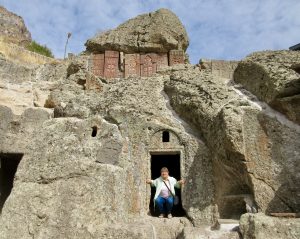
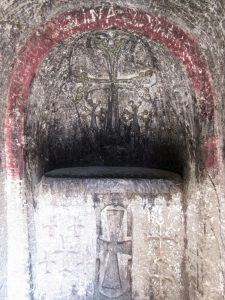

We took a quick look inside some cave cells, wandered around the back side of the complex to take a quick look at the backside of caves, the gorgeous views of the massive cliffs surrounding the monastery, crossed a bridge over the Azat River where people tie cotton to the trees and make a wish and then called it good.
As we were leaving, Diane and I stopped at a food stall (there were many) where a woman insisted we try her sujukh gata (sweet cake with honey, sugar and walnuts). This was the same cake we had tried at the Haghartsin Monastery. The cake we actually tried, had no walnuts, and was far superior to what we tried at the Haghartsin Monastery so of course, I bought half a round of the bread and then couldn’t get Diane or Nour to try it since we were heading off for lunch.

Now lunch turned out to be pretty cool. The restaurant was Mer Ojakh, a highly rated family home restaurant in the village of Garni. First, I was given a lavash (bread) making demonstration. Now I have seen the bread made already, but this demonstration was far more in depth, and I actually got up pretty close so I could see how the ladies used a large pillow like tool to slap the bread against the underground oven. I was also able to time how long it took to bake the very thin lavash and it actually took only about 60 seconds. Very quick.
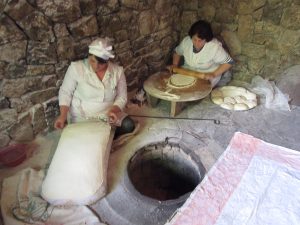
After the breadmaking demo, we took a seat in the garden and were served some lovely salads, the lavash we saw made with cheeses, as well as fabulous meat kabobs and fish. I even tried a shot o homemade peach vodka. (I think it is still burning a hole in my stomach!). And of course, for desert, there was more sujukh gata. (As if I have not had enough bread and sweats on this trip around Armenia).
Once lunch was over, Nour and Diane drove me back to Yerevan and to the airport for my early evening flight to Dubai. It was sad to say goodbye to yet more fabulous humans I have met on this trip. Nour was absolutely wonderful and periodically provided input on the area we were travelling in and often provided me with suggestions on books to read about the history of Armenia. (I have a long list.). And Diane was a wealth of information and a truly lovely person to travel with around Armenia. I highly, highly recommend you visit Armenia, if for nothing else, but the food and fabulous people.

So now it was on to Dubai for a couple days before the long journey back across the Atlantic to South America. My blog will probably go dark until next Tuesday since I do not plan to write about Dubai or my long ass trip to Salvadore, Brazil, although I may post a picture of the inside of the Emirates plane as I am supposed to be travelling on the A380 with the showers and middle of the cabin bar. If it happens, there will be pictures. Until Brazil, see ya!
